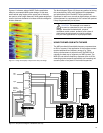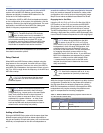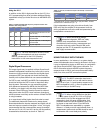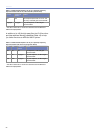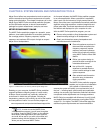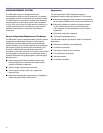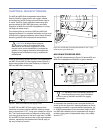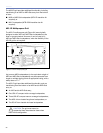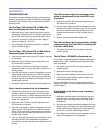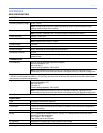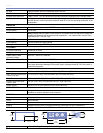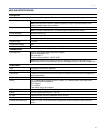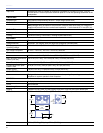
27
APPENDIX A
TROUBLESHOOTING
This section contains possible solutions to some common
problems encountered by M2D and M2D-Sub loudspeaker
users and is not intended to be a comprehensive trouble-
shooting guide.
The On/Temp. LED (Active LED on M2D-Sub)
does not illuminate and there is no audio.
1. Make sure the AC power cable is the correct type for
the regional voltage and that it is securely connected to
the AC inlet, then unplug and reconnect the AC cable.
2. Use an AC voltmeter to verify that the AC voltage is
within the ranges 90 - 265 V AC.
3. If the On/Temp LED still fails to illuminate, call Meyer
Sound Technical Support.
The On/Temp. LED (Active LED on M2D-Sub) is
illuminated green but there is no sound.
1. Verify that the audio source (mixer, EQ, delay) is sending
a valid signal.
2. Make sure the XLR cable is securely fastened to the
XLR audio input connector.
3. Verify that the XLR cable is functioning by substitut-
ing another cable or by using the cable in question in a
working system.
4. Send the audio signal to another loudspeaker to insure
signal presence and that the level is within the proper
range. Turn the source level down before reconnecting
the audio input and increase the level slowly to avoid a
sudden blast of sound.
5. If possible, monitor the audio source with headphones.
Hum or noise is produced by the loudspeaker.
1. Disconnect the audio input. If the noise persists, the
problem is within the loudspeaker. In this case return
the unit to the factory or nearest authorized service cen-
ter. If the hum ceases, the noise originates somewhere
earlier in the signal path.
2. Make sure the XLR cable is securely fastened to the
XLR audio input connector.
3. Send the audio signal to another loudspeaker to insure
signal presence and that the level is within the proper
range. Turn the source level down before reconnecting
the audio input and increase the level slowly to avoid a
sudden blast of sound.
4. Hum or noise can be produced by a ground loop. Since
the M2D and M2D-Sub loudspeakers are effectively
ground-lifted, the loop must be broken elsewhere in the
system.
The audio produced by the loudspeaker is dis-
torted or compressed but the Limit LED is not
illuminated.
1. Make sure the XLR cable is securely fastened to the
XLR audio input connector.
2. Send the audio signal to another loudspeaker to insure
that the level is within the proper range. Turn the source
level down before reconnecting the audio input and
increase the level slowly to avoid a sudden blast of
sound.
3. Monitor the audio source with headphones.
The audio produced by the loudspeaker is highly
compressed and the Limit LED is constantly yel-
low (red on M2D-Sub).
1. Turn down the level of the input signal to the loud-
speaker system.
The On/Temp. LED (M2D) is illuminated red.
This occurs in conditions where the heatsink temperature
reaches 85°C (185°F), indicating that the amplifier is ther-
mally overloaded.
1. Turn down the level of the input signal to the loud-
speaker system.
2. Make sure the fan is working properly.
3. Make sure there is sufficient air flow around the unit.
4. Avoid exposing the heatsink to direct sunlight if the
ambient temperature is high.
See the amplification, limiting, cooling system sections
beginning on page 10 for a complete discussion about the
cooling system.
Only the high or low drivers seem to produce
sound (M2D).
1. Make sure the audio signal is full-range and has not
been filtered in a previous stage of the signal chain. If
possible, monitor the audio source with high-quality
headphones.
2. Send the audio signal to another loudspeaker to insure
that the signal is full-range. Turn the source level down
before reconnecting the audio input and increase the
level slowly to avoid a sudden blast of sound.
3. Use a sine wave and/or pink noise generator to send a
variety of frequencies to the loudspeaker.
APPENDIX A



